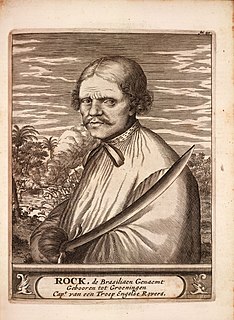 W
WThe Arumer Zwarte Hoop, meaning "Black Army of Arum" was an army of peasant rebels and mercenaries in Friesland fighting against the Habsburg authorities from 1515 to 1523. For four years they were successful under the former farmer Pier Gerlofs Donia. Led by his Lieutenant Wijerd Jelckama from 1519 they slowly lost ground and were captured and executed in 1523.
 W
WWillem Bloys van Treslong was a nobleman from the Southern Netherlands and military leader during the Dutch war of Independence. He was best known as one of the leaders of the Sea Beggars who captured Den Briel on 1 April 1572.
 W
WRoche Braziliano was a Dutch pirate born in the town of Groningen. His pirate career lasted from 1654 until his disappearance around 1671. He was first made famous in Alexandre Exquemelin's 1678 book The Buccaneers of America; Exquemelin did not know Braziliano's real name, but historians have found he was probably born as Gerrit Gerritszoon and that he and his parents moved to Dutch-controlled Brazil. He is known as "Roche Braziliano", which in English translates to "Rock the Brazilian", due to his long exile in Brazil.
 W
WPier Gerlofs Donia was a Frisian rebel leader and pirate. He is best known by his West Frisian nickname Grutte Pier, or by the Dutch translation Grote Pier which referred to his legendary size and strength.
 W
WJoost van Dyk was a Dutch privateer who was one of the earliest European settlers in the British Virgin Islands in the seventeenth century, and established the first permanent settlements within the Territory. The islands of Jost Van Dyke and its smaller neighbor Little Jost Van Dyke, as well as Little Dix Bay on Virgin Gorda island, are named after him.
 W
WLaurens Cornelis Boudewijn de Graaf was a Dutch pirate, mercenary, and naval officer in the service of the French colony of Saint-Domingue during the late 17th and early 18th century.
 W
WBoudewijn Hendricksz was a Dutch corsair and later Admiral. He is most famous for his role in the Battle of San Juan (1625) during the Eighty Years' War, in which he tried but failed to capture San Juan from Spanish forces. In the same year, prior the assault on San Juan he attempted to recapture Bahia, Brazil after the Spanish overcame Dutch forces in the city.
 W
WNicholas van Hoorn was a merchant sailor, privateer and pirate. He was born in the Netherlands and died near Veracruz after being wounded on the Isla de Sacrificios. Nikolaas or Klaas was engaged in the Dutch merchant service from about 1655 until 1659, and then bought a vessel with his savings. With a band of reckless men whom he had enlisted, he became a terror to the commerce of the Dutch Republic and the Spanish Empire. Later he had several ships in his employment and obtained such notoriety that some governments were willing to employ him against their enemies.
 W
WWilliam II de la Marck was the Dutch Lord of Lumey and initially admiral of the Watergeuzen, the so-called 'sea beggars' who fought in the Eighty Years' War (1568–1648), together with among others William the Silent, Prince of Orange-Nassau. He was the great-grandson of an equally notorious character, baron William de la Marck, nicknamed the "wild boar of the Ardennes".
 W
W"Pallache" – also de Palacio(s), Palache, Palaçi, Palachi, Palacci, Palaggi, and many other variations – is the surname of a prominent, Ladino-speaking, Sephardic Jewish family from the Iberian Peninsula, who spread mostly through the Mediterranean after the Alhambra Decree of March 31, 1492, and related events.
 W
WVan Tuyl is the surname of the Dutch family from which many North American Van Tuyls, Van Tuyles, Van Tyls and Van Tyles are descended. The family name derives from the ancient village of Tuil (Tuÿl), in the central Netherlands. The family's earliest proven ancestor is the 14th-century knight Heer Ghijsbrecht van Tuyl of Gelre. This family is distinct from the Van Tuyll van Serooskerken family.